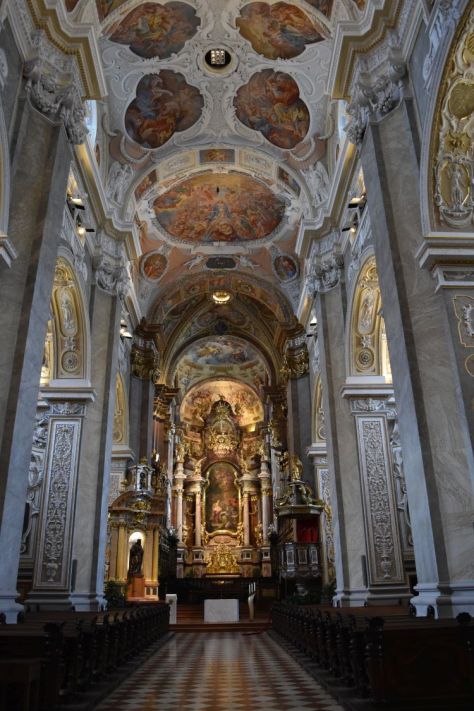It is a rainy October day in and around Vienna. Our friends take the car out of the narrow, narrow garage and drive north of Vienna to the hills of the Wienerwald and the wetlands of the Danube.
.
Grinzing – THE tourist place for Heurigen
This is a quick impression of Grinzing located north of Vienna. It is THE tourist place for “Heurigen” (taverns that serve new wine). The Trummelhof is their most traditional tavern – its roots go back to the times of the House of Babenberg around 1150.
.
Altenberg and the wetlands of the Danube – the home of excellent scientists
We continue our way to Altenberg where my friends have family roots. They were neighbors of Konrad Lorenz that here, in the wetlands of the Danube, studied geese, crows and dogs (he owned a mixture of chow and shepherd). My gift drawer always contains his book “So kam der Mensch auf den Hund” (“Man meets Dog”). Another of their neighbors was Karl Popper – his thoughts about conjectures and refutations (Verifikation und Falsifikation) had shaped my critical mind about statistical analysis and making hypotheses. And all these achievements had their foundation in this small village of Altenberg north of Vienna.
.
The Wienerwald with Lourdes
The hills north of Vienna are called “Wienerwald”. Wienerwald? When I was young, this was the name of a chain of restaurants that provided poultry with french fries – often in baskets. Now I see, this is also the name of the hills north of Vienna. From here the Polish king Sobieski attacked and defeated the Turks in 1683, when they besieged Vienna.
In the hills there is a pilgrimage place called Lourdes (pronounced Lurd-e-s). The Granma of the cousin of my friends had donated the land to set up the pilgrimage, though being protestant. Today we are alone here in the pouring rain. We find the guard in his small wooden house near the site and buy a map. He is surprised to see guests on this rainy day.
Nearby we escape the rain in the restaurant Waldhaus (there are even rain drops on my optical lens).
We sit down in the cosy room. I have roasted pork with Serviettenknödel. I learn that for “Serviettenknödel” you roll up the paste in a napkin (Serviette) and then cut pieces from the resulting “snake”. My meal was solid, but tasty. With it we drink “Sturm”. This is freshly fermented raisin juice – and when it becomes available in Vienna, they announce it as “Sturm-Alarm” (“storm alarm”).
.
Kloster Stift Neuburg – Monastery and Wine Cellar
After our tasty and solid meal we stop in Neuburg on a rocky hill above the Danube. The margraves and dukes of Babenberg are still very present here. Hotels and restaurants are called after them. The Babenbergs had died out in the 13th century – then the Habsburgians took over in Austria.
The Babenbergs founded the monastery Kloster Stift Neuburg in the 12th century. It was an Augustinian monastery for women.
The church inside is baroque.
We visit the wine production and the caves that go down 35m in the rock to reach the level of the Danube. The walls are 10m thick, with a gap that allows the air to circulate and keep the cellar dry. The oldest wine bottle stored here is from 1938. Also the museums of Vienna use the excellent climate of the cellars to store material in it.
I learn about the Austrian white grapes called Rotgipfler and Zierfandler. This is an assemblage of the two.
I buy some St.Laurent, a Pinot Noir that made a gold medal and Patronis, which is dedicated to Leopold and Agnes, the founders of the monastery.
There is a legend related to the foundation of the monastery. When Margrave Leopold III of Babenberg married Agnes von Waiblingen, a sudden windswept carried away the veil of Agnes. Nine years later Leopold found the veil in the forest on an elder bush – undamaged. He decided that this must be a sign of Heaven telling him to build the monastery here – and he founded this monastery – Kloster Stift Neuburg. The plate at the entrance to the wine cellar illustrates the legend.
.
Culture in the evening: Tschaikowskij in the Musikverein
We finish off the day in the Musikverein (Grosser Saal). Vladimir Fedosejev directs the Vienna Symphony Orchestra. He is 84 years old and vital. The orchestra plays Tschaikowskij. Andrei Korobeinikovs (born in 1986) plays the piano in the b-Moll-piano concert. The young pianist makes a great impression on me. The comment about this Russian evening is enthusiastic. Thank you for this.







